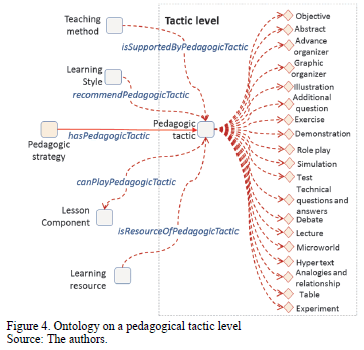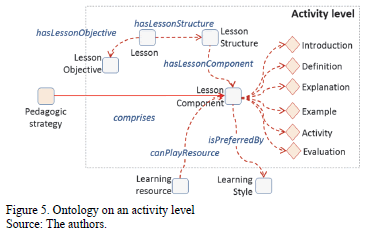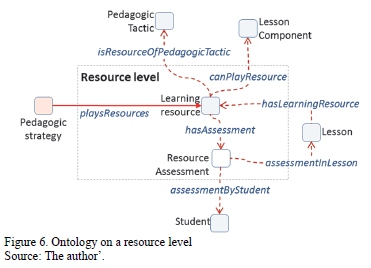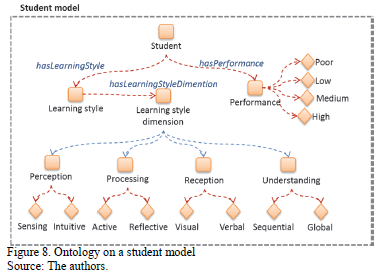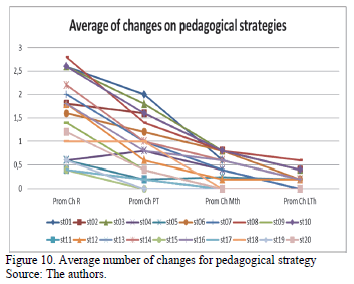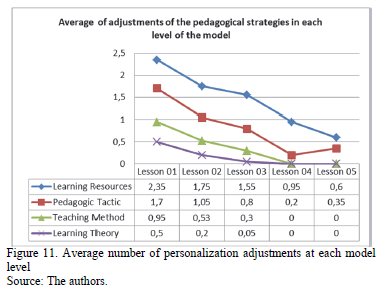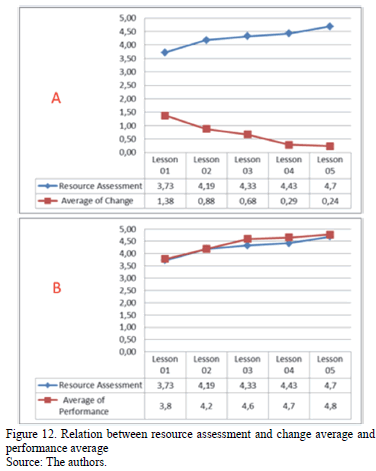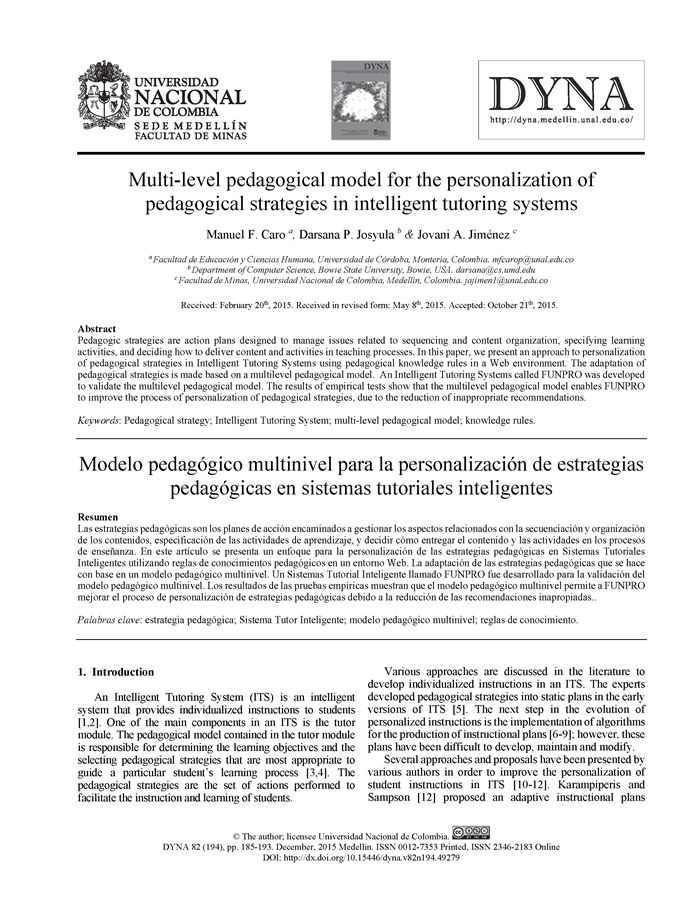
Publicado
Multi-level pedagogical model for the personalization of pedagogical strategies in intelligent tutoring systems
DOI:
https://doi.org/10.15446/dyna.v82n194.49279Palabras clave:
Pedagogical strategy, Intelligent Tutoring System, multi-level pedagogical model, knowledge rules. (es)
Descargas
DOI: https://doi.org/10.15446/dyna.v82n194.49279
Multi-level pedagogical model for the personalization of pedagogical strategies in intelligent tutoring systems
Modelo pedagógico multinivel para la personalización de estrategias pedagógicas en sistemas tutoriales inteligentes
Manuel F. Caro a, Darsana P. Josyula b & Jovani A. Jiménez c
a Facultad de Educación y Ciencias Humana, Universidad de Córdoba, Montería,
Colombia. mfcarop@unal.edu.co
b Department of Computer Science, Bowie State
University, Bowie, USA. darsana@cs.umd.edu
c Facultad de Minas, Universidad Nacional de Colombia, Medellín, Colombia.
jajimen1@unal.edu.co
Received: February 20th, 2015. Received in revised form: May 8th, 2015. Accepted: October 21th, 2015.
This work is licensed under a Creative Commons Attribution-NonCommercial-NoDerivatives 4.0 International License.
Abstract
Pedagogic strategies are
action plans designed to manage issues related to sequencing and content
organization, specifying learning activities, and deciding how to deliver
content and activities in teaching processes. In this paper, we present an
approach to personalization of pedagogical strategies in Intelligent Tutoring
Systems using pedagogical knowledge rules in a Web environment. The adaptation
of pedagogical strategies is made based on a multilevel pedagogical model. An Intelligent Tutoring Systems called FUNPRO
was developed to validate the multilevel pedagogical model. The results of
empirical tests show that the multilevel pedagogical model enables FUNPRO to
improve the process of personalization of pedagogical strategies, due to the
reduction of inappropriate recommendations.
Keywords: Pedagogical strategy; Intelligent Tutoring System; multi-level pedagogical model; knowledge rules.
Resumen
Las estrategias pedagógicas son los planes de
acción encaminados a gestionar los aspectos relacionados con la secuenciación y
organización de los contenidos, especificación de las actividades de
aprendizaje, y decidir cómo entregar el contenido y las actividades en los
procesos de enseñanza. En este artículo se presenta un enfoque para la
personalización de las estrategias pedagógicas en Sistemas Tutoriales Inteligentes
utilizando reglas de conocimientos pedagógicos en un entorno Web. La adaptación
de las estrategias pedagógicas que se hace con base en un modelo pedagógico multinivel.
Un Sistemas Tutorial Inteligente llamado FUNPRO fue desarrollado para la
validación del modelo pedagógico multinivel. Los resultados de las pruebas
empíricas muestran que el modelo pedagógico multinivel permite a FUNPRO mejorar
el proceso de personalización de estrategias pedagógicas debido a la reducción
de las recomendaciones inapropiadas..
Palabras clave: estrategia pedagógica; Sistema Tutor Inteligente; modelo pedagógico multinivel; reglas de conocimiento.
1. Introduction
An Intelligent Tutoring System (ITS) is an intelligent system that provides individualized instructions to students [1,2]. One of the main components in an ITS is the tutor module. The pedagogical model contained in the tutor module is responsible for determining the learning objectives and the selecting pedagogical strategies that are most appropriate to guide a particular student's learning process [3,4]. The pedagogical strategies are the set of actions performed to facilitate the instruction and learning of students.
Various approaches are discussed in the literature to develop individualized instructions in an ITS. The experts developed pedagogical strategies into static plans in the early versions of ITS [5]. The next step in the evolution of personalized instructions is the implementation of algorithms for the production of instructional plans [6-9]; however, these plans have been difficult to develop, maintain and modify.
Several approaches and proposals have been presented by various authors in order to improve the personalization of student instructions in ITS [10-12]. Karampiperis and Sampson [12] proposed an adaptive instructional plans model, based on the use of ontologies. Although the instructional plan model can replan on its own when a student has trouble achieving his or her learning objectives, replanning takes place in terms of resources used and not in terms of pedagogical strategies.
Arias, Jiménez, and Ovalle proposed a model of instructional planning using Case-Based Reasoning (CBR) [13]. This model allows instructions to be adapted in order to meet the specific needs of each student. A major limitation of this model is that the activity plans that are generated can be incomplete if the case characteristics do not adequately cover the entire solution space.
More recently, personalization approaches have focused on the pedagogical model of the tutor module of the ITS. Barros [3] presented a pedagogical model designed using an ontology called pedagogical ontology. However, the model does not have mechanisms to auto adjust the strategies established by the ontology.
None of the studies reviewed to date has been designed with all three learning theories elements, teaching methods, and teaching tactics used in each stage of the lesson, within the same model.
The design of mechanisms for the formulation of pedagogical strategies in Intelligent Tutoring Systems is a complex task due to the number of variables involved. In particular, the selection of the methods or pedagogic tactics to be used for the development of a certain lesson requires the ITS to hold an extensive repertoire of pedagogical knowledge. In many cases, the ITS generates recommendations that are inappropriate for the student in terms of their profile or preferences. Inappropriate recommendations affect student performance in the lesson due to inconsistencies in the presentation of resources and an inadequate level of content or strategy to address the lesson.
In this context, the aim of this paper is to present a new approach to a pedagogical model for the personalization of pedagogical strategies in ITS. The proposed pedagogical model allows the ITS to personalize pedagogical strategies into five levels: learning resources, activity level, pedagogical tactics level, teaching methods, and educational theories level. Personalization can be based on student profile, dynamicity of student interaction, or be experience-based. The model allows the ITS a higher level of personalization of the pedagogical strategy in order to reduce the number of inappropriate recommendations for the student.
An ITS called FUNPRO was developed to validate the multilevel pedagogical model. The reasoning performed by the system is based on rules and pedagogical knowledge that is represented in the form of ontologies. The empirical tests results showed the high adaptive capacities that the multilayer model provides to FUNPRO.
The primary objective of the ITS is to provide personalized instruction [1,2]. Therefore, the main module of an ITS is the tutor module [14]. The tutor module is also known in the literature as the Instructional Planner [5,13,15].
The pedagogic model inside the tutor module has educational functions. It is responsible for guiding the teaching-learning process and deciding what pedagogical actions are undertaken, how, and when [1,13]. In ITS, the pedagogical model contained in the tutor module is responsible for determining the learning objectives and selecting pedagogical strategies that are most appropriate to guide the learning process of a particular student [3,4,16,17].
The instructional plan configures the pedagogic strategy used for each student. The purpose of the pedagogic strategies is to facilitate student instruction and learning [18]. Pedagogic strategies, in general, refer to abstract teaching methods [19]. Pedagogic strategies are oriented towards configuring activities and interfaces between the student and the imparting of learning process. In educational environments, the pedagogic strategies are action plans designed to manage issues related to sequencing and organizing instructional content [8], specifying learning activities, deciding how to deliver the content [19], and employing pedagogic tactics [4].
The main contribution of this work is the incorporation of levels of personalization in pedagogical strategies. Levels allow for a greater number of customization aspects in the pedagogical strategy. Each level of the model represents a component of the pedagogical strategy; at each level, the ITS collects data, undertakes reasoning and, if inappropriate, reconfigures recommendations that are generated.
This paper is organized as follows, Section 2 presents the architecture proposed for a pedagogic model in Intelligent Tutoring Systems, and the personalization rules implemented in this work are explained. Section 3 presents the methodology used to validate the pedagogical model. Section 4 presents an analysis of empirical data that was collected from the validation test. Finally, Section 5 discusses the main conclusions and future work
2. The multi-level pedagogical model
The pedagogical model is multilevel in order to enrich the possibilities for personalization of pedagogical strategies. The pedagogical strategy is personalized at each level according to each student's characteristics. The following five abstraction levels compose the proposed pedagogic model: Theory level, Method level, Tactic level, Activity level, and Resource level, see Fig. 1.
Each level of the pedagogical model is represented by ontologies. For the definition of educational domain terminology and for pre-selection of the teaching methods and pedagogical tactics, a literature review was carried out. Then, several meetings were held with a group of experts from the Department of Educational Psychology at the Universidad de Córdoba (COL). In these sessions, terminology was validated and the pedagogical tactics to be implemented were selected. In this way, elements of the pedagogical model's structure, described below, were defined.
2.1. Theory level
Learning theories are composed of a diverse set of theoretical frameworks, which try to explain how individuals access knowledge. Many features of pedagogical theories can be partially modeled by computer. In this paper, we have only included those characteristics that can be modeled computationally: the type of content sequencing, the type of assistance provided to students, and the type of evaluation, see model in Fig. 2.
The proposed model supports two types of educational theories: behaviorism and constructivism. The characteristics of the behaviorism theory that are supported by the multilevel model are: linear navigation between contents, immediate reinforcement, and organization of content for levels with prerequisites.
Moreover, constructivist features supported by the multilevel model are: free navigation between content, content organization with minimal and necessary prerequisites, formative assessment, and activities for active student participation.
2.2. Method level
A teaching method is comprised by the principles that include an orderly logical arrangement of the tactics and activities that are used in course lessons. The teaching methods are based on pedagogical theories; each method may contain all or part of the pedagogical principles in the theories, see Fig. 3.
The isBasedOn relationship determines the learning theory, which is based on a teaching method and establishes the content's organization. The is Supported By Pedagogical Tactic relationship, however, allows the association of the pedagogical tactics that will be used in the teaching method.
2.3. Tactic level
Tutor Module provides the learning objectives based on student characteristics. In addition, Tutor Module offers a range of pedagogic tactics for the student to achieve the learning objectives that have been established for him. Pedagogic Tactics are composed of actions and resources that are used in the interaction with the student [4] in order to provide a personalized teaching experience. The selection criteria used to include a pedagogic tactic in the Tutor Module was that such tactic can be modeled computationally [18,20]. In this work 19 pedagogic tactics were implemented (see Fig. 4).
The canPlaysPedagogicalTactic relationship allows the pedagogical strategy to be associated with one or more lesson components. When a new learning resource is added, a new isResourceOfPedagogicalTactic relationship is created.
2.4. Activity level
The components of the lesson are the sections in which the lesson activities are organized. Fig. 5 shows the model of activity level.
The division of the lesson into sections has been widely used in the teaching practice [5,21,22]. Specifically, our proposal for lesson components is based on [22]; however, we make some modifications to adjust it to an education context in our university. Our proposed model suggests that there are six sections in the structure of a lesson: introduction, definition, explanation, example, activity, and evaluation.
In the Introduction section the objectives and information about the context of the lesson are presented. In the Description, the definitions and concepts related to the lesson are displayed. The Explanation section delves into concepts and issues relevant to the lesson. In the Example section, examples and demonstrations are provided that are related to the lesson's themes. In the Activity section, active pedagogical tactics, such as experiments, simulations, and exercises are employed. Finally, in the Evaluation section questionnaires and various types of tests to measure student achievement in the lessons are presented.
2.5. Resource level
Learning resources are digital objects such as images, animations, simulations, web pages, and more. Learning resources are the content carriers in the lesson and have different formats. Fig. 6 shows the relationship between the resource level and other of the model's components.
Students have the opportunity to assess the learning resources that the instructional planner recommends for each component of the lesson. The assessment is based on a scale of 1-5 as follows: (1) The resource was of no use in learning the lesson's subject, (2) the resource made little contribution to learning the lesson's topic, (3) the resource partially contributed in learning the lesson, (4) the resource was useful for the lesson, and (5) the resource was very useful for learning the lesson's topic.
2.6. Personalization of pedagogical strategies
The pedagogical strategy has an internal representation consisting of three sections: context, recommendation, and performance, see Fig. 7.
The context section contains the input data used to configure the pedagogical strategy, which are: student information, course, and lesson. The recommendation section contains the settings for the pedagogical strategy, which are adapted to the student. This section consists of the navigation style, pedagogical theory, the teaching method, the components of the lesson that are enabled to students, and pedagogical tactics for each component. The performance section stores the result of the recommendation for a particular student's strategy. The performance of the strategy depends on the performance of the student in the lesson and has a scale of low, medium, and high.
Following the personalization process, the pedagogical strategy at each level of the model is described. Applying the rules of reasoning that comprise the pedagogical knowledge element of the model makes the personalization.
2.7. Personalization in learning theory's recommendations
The pedagogical strategies are implemented using learning theories criteria; otherwise, they would be limited to sequence of activities and tasks that do not have a clear educational purpose [23].
When a new student is registered, a profile is created immediately. The student fills out a form to generate his learning style profiles. When a registered student enters into the ITS, the pedagogical model activates the corresponding student model to adapt the teaching session. Preferences and indicators related to the student's level and learning style are obtained from the student model, see Fig. 8.
The approach used in this work to model the student learning style was based on the model developed by Felder [24]. Then, the following processes perform the personalization of pedagogical strategies on a learning theory level:
Profile-based adaptation: The adaptation takes the student's learning style into account as input parameters, including the dimension of understanding. For example, if the student has a predisposition that favors the sequential development of content, then the system will recommend a pedagogical strategy based on behaviorism. Otherwise, it will recommend a teaching strategy based on constructivism.
Rule 1:
Student (?s) ^ hasLearningStyle (?s, sequential) ^
HaslearningStyleDimension (?ls, understanding)
→ playsLearningTheory (?s, behaviorism) (1)
Dynamic adaptation occurs when the recommended tactic for teaching a lesson is changed for a new one. If the new pedagogical tactic is based on a different pedagogical theory, the pedagogical strategy and student profile are updated.
Rule 2:
TeachingMethod (?tm) ^ TeachingMethod (?new_tm) ^
isbasedOnLearningTheory (?tm , ?lt) ^
isbasedOnLearningTheory (?new_tm, ?lt') ^
¬( LearningTheory (?lt) = LearningTheory (?lt') )
→ playsLearningTheory (?s, ?lt') (2)
2.8. Personalization in the teaching method recommendation
The adaptation at method level is performed in the following ways:
Adaptation is based on the theory of learning. Each teaching method is influenced by one or more learning theories. Thus, if it is recommended that the student use the constructivist theory of learning then this recommendation will be based on constructivist methods.
Rule 3:
Student (?s) ^ hasLearningStyle (?s, ?ls) ^ LearningStyle(?ls) ^
isSupportedByLearningTheory (?ls, ?lt) ^ LearningTheory (?lt) ^
isBasedOnLearningTheory(?ls, ?tm) ^ TeachingMethod (?tm)
→ implementsTeachingMethod (?s, ?tm) (3)
Dynamic adaptation occurs when the recommended tactic for teaching a lesson is changed for a new one. If the new pedagogical tactic is based on a different teaching method, the pedagogical strategy and student profile are updated.
Rule 4:
PedagogicTactic (?pt) ^
PedagogicTactic (?new_pt) ^
isSupportedByTeachingMethod (?pt , ?tm) ^
isSupportedByTeachingMethod (?new_pt, ?tm') ^
¬( TeachingMethod (?tm) = TeachingMethod (?tm') )
→ implementsTeachingMethod (?s, ?tm')(4)
2.9. Personalization in the pedagogic tactic's recommendation
The personalization of pedagogical strategies on a pedagogical tactics level is performed in the following ways:
Profile-based adaptation: The pedagogical tactics recommendation of is carried out based on the student profile.
Rule 5:
Student (?s) ^ hasLearningStyle (?s, ?ls) ^ LearningStyle(?ls) ^
implementsTeachingMethod(?s, ?tm) ^ TeachingMethod(?tm) ^
givesSupportToPedagogicTactic(?tm, ?pt) ^
isSupportedByPedagogicTactic (?ls, ?pt) ^ PedagogicTactic (?pt) ^
canPlayInLessonComponent (?pt, ?lc)
→ playsPedagogicTactic (?lc, ?pt) (5)
In this study, 19 pedagogic tactics were implemented, see Fig. 3. The selection of the pedagogical tactics was based on [4,18,20].
Dynamic Adaptation: This type of adaptation occurs when a student changes a recommended resource for a lesson with a new one. In this case, if the new resource supports a different kind of pedagogical tactic, the system reconfigures the recommendation preferences for the student and states that the tag recommendation is inappropriate.
Rule 6:
LearningResource (?current_lr) ^ LearningResource (?new_lr) ^
isResourceOfLessonComponent (?new_lr , ?lc) ^
isResourceOfPedagogicTactic (?new_lr, ?pt') ^
isResourceOfPedagogicTactic (?lr , ?pt) ^
¬( PedagogicTactic (?pt) = PedagogicTactic (?pt') )
→ playsPedagogicTactic (?lc, ?pt') (6)
2.10. Personalization in the learning resources recommendation
Adapting pedagogical strategies on a resource level occurs in the following cases:
Profile-based adaptation: Consists of the recommendation of resources according to the characteristics of the student profile.
Rule 7:
Student (?s) ^ hasLearningStyle (?s, ?ls) ^ LearningStyle(?ls) ^
canUseTeachingMethod(?s, ?tm) ^ TeachingMethod(?tm) ^
givesSupportToPedagogicTactic(?tm, ?pt) ^ PedagogicTactic (?pt) ^ isSupportedByPedagogicTactic (?ls, ?pt) ^ canPlayInLessonComponent (?pt, ?lc) ^ LearningResource (?lr) ^
isResourceOfLessonComponent (?lr , ?lc) ^
isResourceOfPedagogicTactic (?lr , ?pt)
→ playsLearningResource (?pt, ?lr) (7)
Rule 7 is conditioned by the context of the pedagogical strategy and the result of the student evaluation for the learning resource after its use during the lesson. The resources are sorted from highest to lowest evaluation result. The model selects the resource with the highest performance.
Adaptation by preference: This type of recommendation occurs when a student changes the recommended learning resource to a different resource. In this case, the system updates the student's preferences according to the characteristics of the newly selected resource, and the new profile will be used to give new recommendations.
Rule 8:
LearningResource (?current_lr) ^ LearningResource (?new_lr) ^ isResourceOfLessonComponent (?new_lr , ?lc) ^
isResourceOfPedagogicTactic (?new_lr, ?pt) ^
isResourceOfPedagogicTactic (?lr , ?pt') ^
PedagogicTactic (?pt) = PedagogicTactic (?pt')
→ playsLearningResource (?pt, ?new_lr) (8)
3. Methodology
An ITS, to be used to learn Programming Fundamentals (FUNPRO) was developed using a MODESEC [25] methodology, and it is based on introspective learning [26]. FUNPRO was used to validate the multi-level pedagogic model and was developed entirely in SWI-Prolog. To edit the graphical interface, Notepad + + was used, see screenshot in Fig. 9.
3.1. Configuration of the experiment
A practical experiment was conducted in order to verify the personalization level of pedagogical strategies with respect to the preferences and profiles of students using FUNPRO. The experiment was conducted with 20 students undertaking an introductory course in programming. The course consisted of five lessons and had a basic level of complexity.
The performance metric used to measure the personalization level of pedagogical strategies was the average of changes made to the pedagogical strategies recommended at each model level. Changes in pedagogical strategies can be made directly by the student (e.g. when the student changes a learning resource) or dynamically (e.g., when the ITS detects a change in the student's learning preferences).
Changes made to the teaching strategy components, recommended for each student, will be interpreted as inappropriate recommendations. In this sense, if the amount of changes needed to adjust the pedagogical strategy according to the student's profile is high, and then the level of personalization of the teaching strategy will be low. Thus, the aims of the experiment were to see whether the multi-layer pedagogical model could increase the level of personalization of pedagogical strategies by reducing changes to the recommended strategy for each student in each lesson of the course, and also to observe if the reduction of inappropriate recommendations had a positive effect on student performance during the lesson.
4. Results
Data from the experiment will be described with respect to i) personalization of pedagogical strategies to the student profile at each level of the model and, ii) the relationship observed between the evaluation made by students in terms of learning resources and the changes made system to the pedagogical strategy.
i) Personalization of pedagogical strategies
In the data obtained from the experiment, with respect to the behavior of the adaptation of the pedagogical strategy to the student profile at each level of the model, the average number of adaptations per student observed at level of learning resources was 1.44. The average number of pedagogic tactic level adaptations was 0.82, the average number of adaptations at teaching method level was 0.35, and the average number of adaptations at learning theory level was 0.15.
Fig. 10 shows that the model level with the most number of adaptations was learning resource, and the level where there were fewer adjustments was learning theory.
With respect to the occurrence of adaptation generated by the relationship between the levels, it can be said that 56.9% of resource changes made by the student generated changes in pedagogical tactics by applying rule (7). 42.7% of pedagogical tactic changes generated teaching method changes by applying rule (4), and 42.9% of teaching method changes generated Learning Theory changes for pedagogical strategy as a result of rule (2).
Fig. 11 shows the data on the average number of adaptations to the pedagogical strategy in each model level for each lesson in the course. With respect to the average of changes made to the pedagogical strategy recommended, a reduction of adaptations in each component of the strategy, while the student progresses in the course, is observed.
The results show that while the student's progress in the course, the system adapts its pedagogical strategy. Thus, for each new lesson the amount of required adjustments are minimal. Decreasing the number or adjustments indicates that as the student uses the system, the multilevel model improves recommendations for each component of the pedagogical strategy.
ii) Relationship between the resource evaluation and the changes made to the pedagogical strategy
Section (A) Fig. 12 shows the inverse relationship found between the average number of resources assessments made by student and the changes to the pedagogical strategy.
Students evaluate by giving the best score to which they prefer: the learning resources included in the teaching strategy in a new lesson or those learning resources that were recommended in a previous lesson. As the student evaluation of learning resources improves, there is a decrease in the percentage of adaptations required to personalize the pedagogical strategy. This is because the system learns with each adaptation to the pedagogical strategy, in turn producing better recommendations at each model level.
Section (B) of Fig. 12 shows the relationship between evaluations of learning resources and student performance in each lesson. When recommendations at each level of the pedagogical strategy are adapted to the profile of the student, an improvement in the student performance in the next lesson is observed.
5. Conclusions
In this paper, we have presented a multi-level pedagogical model-based on ontologies for the personalization of pedagogical strategies in ITS. Personalization of pedagogical strategies is made using rule-based reasoning. In this way, the structure of a pedagogical model for ITS, the main elements of which are the theories of learning, pedagogic strategies, and pedagogic tactics was defined.
The pedagogical tactics, teaching methods, and learning theories supported by the model, were determined by experts in Educational Psychology and supported by a literature review.
An ITS was used to learn about an introduction to programming (FUNPRO) by using MODESEC methodology. This was developed to validate the multi-level pedagogical model. Rules that create FUNPRO pedagogical knowledge were developed entirely in SWI-Prolog.
The results show that when the students' progress in the course the amount of required adjustments are minor. Decreasing the number of adjustments indicates that the multilevel model improves recommendations on each component of the pedagogical strategy as a result of rule (2, 4 and 7). The evidence found in the data produced in the experiment shows that the proposed multi-level model allows dynamic adaptation of the pedagogical strategy to each student's profile . Adaptations to each model level influence the improvement of student performance in the lessons that follow.
Acknowledgments
The authors thank the Department of Educational Psychology of the Universidad de Córdoba for the support and advice given throughout this work. The scholarship commission of doctoral studies from the University of Córdoba funded this research.
References
[1] Rongmei, Z. and Lingling, L., Research on internet intelligent tutoring system based on MAS and CBR, Conference: International Forum on Information Technology and Applications, IFITA 2009, Chengdu, China, pp. 15-17, May 2009. DOI: 10.1109/IFITA.2009.511.
[2] Wang, Z., Design and implementation of an intelligent tutoring system for English instruction Xuejing Gu 1,2 Jie Hel Siyi Zhengl Wei Wangl 2., Intell. Comput. Intell. Syst. (ICIS), 2010 IEEE Int. Conf., (29-31) Oct, pp. 166-169, 2010.
[3] H. Barros, A. Silva, E. Costa, B. Ig, O. Holanda, and L. Sales, "Steps , techniques , and technologies for the development of intelligent applications based on Semantic Web Services: A case study in e-learning systems," Eng. Appl. Artif. Intell., vol. 24, no. 8, pp. 1355-1367, 2011. DOI: 10.1016/j.engappai.2011.05.007
[4] Bezerra-da Silva, C., Pedagogical model based on semantic web rule language, 12th Int. Conf. Comput. Sci. Its Appl., pp. 125-129, Jun. 2012.
[5] Viccari, R.M. and Jiménez, J.A., ALLEGRO: Teaching / Learning multi-agent environment using instructional planning and cases- based reasoning (CBR ), CLEI Electron. Journal, 10(1), pp. 1-20, 2007.
[6] Jones, J.A. Intelligent tutoring systems: the first component of integrated information systems, Proceedings IEEE Int. Conf. Syst. Man, Cybern., pp. 531-536, 1992. DOI: 10.1109/icsmc.1992.271719
[7] Liu, J., The use of fuzzy reasoning in intelligent computer aided instructional systems, in Multiple-Valued Logic, 1988., Proceedings of the Eighteenth International Symposium on, 1988.
[8] Woo, C.W., Evens, M., Michael, J. and Rovick, A., Dynamic instructional planning for an intelligent physiology tutoring system, Comput. Med. Syst. - Proc. Fourth Annu. IEEE Symp., pp. 226-233, 1991.
[9] Specht, M. and Augustin, D.-S., ATS-adaptive teaching system a WWW-based ITS, Web-Based Knowl. Servers (Digest No. 1998/307), IEE Colloq., 1998.
[10] Espinosa, M.L., Sánchez, N.M., Valdivia, Z.G. and Pérez, R.B., Concept maps combined with case-based reasoning to elaborate intelligent teaching-learning systems, Computer (Long. Beach. Calif)., pp. 205-210, 2007. DOI: 10.1109/isda.2007.33
[11] Graham, C.R., Theoretical considerations for understanding technological pedagogical content knowledge (TPACK), Comput. Educ., 57(3), pp. 1953-1960, 2011. DOI: 10.1016/j.compedu.2011.04.010
[12] Karampiperis, P. and Sampson, D., Adaptive Instructional Planning using Ontologies, Proc. IEEE, 2004.
[13] Arias, F., Jiménez, J. and Ovalle, D., Arias, F., Jiménez, J. y Ovalle, D., Modelo de planificación instruccional en sistemas tutoriales inteligentes, Rev. Avances en Sistemas e Informática, 6(1), pp. 155-164, 2009.
[14] Soh, L. and Blank, T., Integrating case-based reasoning and meta-learning for a self-improving intelligent tutoring system, Int. J. Artif. Intell. Educ., 18(1), pp. 27-58, 2008.
[15] Aguilar, R., Muñoz, V., González, E.J., Noda, M., Bruno, A. and Moreno, L., Fuzzy and multiagent instructional planner for an intelligent tutorial system, Appl. Soft Comput., 11(2), pp. 2142-2150, 2011. DOI: 10.1016/j.asoc.2010.07.013
[16] Seridi, H., Sari, T., Khadir, T. and Sellami, M., Adaptive instructional planning in intelligent learning systems, Sixth IEEE Int. Conf. Adv. Learn. Technol., pp. 133-135, 2006.
[17] Cheung, K.S., Lam, J., Lau, N. and Shim, C., Instructional design practices for blended learning, Int. Conf. Comput. Intell. Softw. Eng., pp. 1-4, Dec. 2010. DOI: 10.1109/cise.2010.5676762
[18] Woo, C.W., Evens, M.W., Freedman, R., Glass, M., Shim, L.S., Zhang, Y., Zhou, Y. and Michael, J., An intelligent tutoring system that generates a natural language dialogue using dynamic multi-level planning., Artif. Intell. Med., 38(1), pp. 25-46, 2006. DOI: 10.1016/j.artmed.2005.10.004
[19] Mizoguchi, R., Hayashi, Y. and Bourdeau, J., Ontology-based formal modeling of the pedagogical world: Tutor modeling, Adv. Intell. Tutoring Syst. 308, pp. 229-247, 2010. DOI: 10.1007/978-3-642-14363-2_11
[20] Peña, C.I., Marzo, J., Lluís, J., Rosa, D. y Fabregat, R., Un sistema de tutoría inteligente adaptativo considerando estilos de aprendizaje, First Galecia Work., 2002.
[21] Amorim, R.R., Lama, M., Sánchez, E., Riera, A. and Vila, X.A., A learning design ontology based on the IMS specification the need for a learning design ontology. 9, pp. 38-57, 2006.
[22] Vesin, B., Ivanović, M., Klanja-Milićević, A. and Budimac, Z., Protus 2.0: Ontology-based semantic recommendation in programming tutoring system, Expert Syst. Appl., 39(15), pp. 12229-12246, 2012. DOI: 10.1016/j.eswa.2012.04.052
[23] Ozdamli, F., Pedagogical framework of m-learning, Procedia - Soc. Behav. Sci., 31, pp. 927-931, 2012. 10.1016/j.sbspro.2011.12.171
[24] Felder, R.M. and Henriques, E.R., Learning and teaching styles in foreign and second language education, Foreign Lang. Ann., 28(1), pp. 21-31, 1995. 10.1111/j.1944-9720.1995.tb00767.x
[25] Caro, M.F., Toscano, R.E., Hermández, F. y David, M.E., Diseño de software educativo basado en competencias, Cienc. e Ing. Neogranadina, 19(1), pp. 71-98, 2009.
[26] Caro, M.F. and Jiménez, J.A., Analysis of models and metacognitive architectures in intelligent systems. DYNA, 80(180), pp. 50-59, 2013
M.F. Caro-Piñeres, is professor at the Department of Educational Informatics at the Universidad de Córdoba, Colombia. Coordinator of the Research Group on Cognitive Informatics and Cognitive Computing - Universidad de Córdoba - Colombia. His areas of interest: cognitive informatics, cognitive computing, metacognition in computation, design of educational software. ORCID: 0000-0001-6594-2187
D.P. Josyula, is associate professor at the Department of Computer Science, in Bowie State University Bowie, USS. MSc. PhD. in Computer Science from the University of Maryland, College Park, USA. Her areas of interest: commonsense reasoning, philosophy of the mind, cognitive modeling, human-computer interaction, and dialog management. ORCID: 0000-0001-7042-1028
J.A. Jiménez-Builes, he was born in Medellin and received his first BSc. degree in Computer Science and Informatics from the University of Medellin, Colombia. He then received his MSc. in Computer Science in 2001 and PhD. in Computer Science, in 2006, all of them from the Universidad Nacional de Colombia; Medellín, Colombia. He has been full time professor of the Faculty of Mines at the Universidad Nacional de Colombia, Medellín, Colombia, since 2005. Additionally, he is the director of the Artificial Intelligence for Education research group, based at the Universidad Nacional de Colombia. ORCID: 0000-0001-7598-7696
Cómo citar
IEEE
ACM
ACS
APA
ABNT
Chicago
Harvard
MLA
Turabian
Vancouver
Descargar cita
CrossRef Cited-by
1. Monika Thapliyal, Neelu Jyothi Ahuja, Achyut Shankar, Xiaochun Cheng, Manoj Kumar. (2022). A differentiated learning environment in domain model for learning disabled learners. Journal of Computing in Higher Education, 34(1), p.60. https://doi.org/10.1007/s12528-021-09278-y.
2. Marcelo Campo, Analia Amandi, Julio Cesar Biset. (2021). A software architecture perspective about Moodle flexibility for supporting empirical research of teaching theories. Education and Information Technologies, 26(1), p.817. https://doi.org/10.1007/s10639-020-10291-4.
3. Juan Sebastián Parra-Sánchez. (2022). Potencialidades de la Inteligencia Artificial en Educación Superior: Un Enfoque desde la Personalización. Revista Tecnológica-Educativa Docentes 2.0, 14(1), p.19. https://doi.org/10.37843/rted.v14i1.296.
4. Manuel F. Caro, Adan A. Gomez, Juan C. Giraldo. (2017). Algorithmic knowledge profiles for introspective monitoring in artificial cognitive agents. 2017 IEEE 16th International Conference on Cognitive Informatics & Cognitive Computing (ICCI*CC). , p.475. https://doi.org/10.1109/ICCI-CC.2017.8109792.
5. Atmane El Hadbi, El Kaber Hachem, Hamid Bourray, Mohammed Hatim Rziki, Houda Oubalahcen. (2024). International Conference on Advanced Intelligent Systems for Sustainable Development (AI2SD'2023). Lecture Notes in Networks and Systems. 931, p.45. https://doi.org/10.1007/978-3-031-54288-6_5.
6. Julia Edeleva, Svetlana Leonova, Anastasiia Brueva, Elena Kostyleva, Aleksandra Meshcheriakova. (2026). Internet and Modern Society. Communications in Computer and Information Science. 2671, p.233. https://doi.org/10.1007/978-3-032-04958-2_18.
7. Maria Ruiz, Idoia Mujika, Arantza Arregi, Pablo Aguirrezabal, David Custodio, Mikel Pajares, Judit Gómez. (2023). EDUKA: Design and development of an intelligent tutor and author tool for the personalised generation of itineraries and training activities in inmersive 3D and 360° educational environments. International Journal of Production Management and Engineering, 11(1), p.31. https://doi.org/10.4995/ijpme.2023.18013.
Dimensions
PlumX
Visitas a la página del resumen del artículo
Descargas
Licencia
Derechos de autor 2015 DYNA

Esta obra está bajo una licencia internacional Creative Commons Atribución-NoComercial-SinDerivadas 4.0.
El autor o autores de un artículo aceptado para publicación en cualquiera de las revistas editadas por la facultad de Minas cederán la totalidad de los derechos patrimoniales a la Universidad Nacional de Colombia de manera gratuita, dentro de los cuáles se incluyen: el derecho a editar, publicar, reproducir y distribuir tanto en medios impresos como digitales, además de incluir en artículo en índices internacionales y/o bases de datos, de igual manera, se faculta a la editorial para utilizar las imágenes, tablas y/o cualquier material gráfico presentado en el artículo para el diseño de carátulas o posters de la misma revista.






